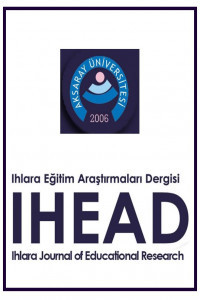7. SINIF ÖĞRENCİLERİNİN ELEKTROSTATİK KONUSUNDAKİ KAVRAMSAL ANLAMALARININ İNCELENMESİ
Bu araştırmanın
amacı ilköğretim 7.sınıflarda öğrenim gören öğrencilerin elektrostatik konusuna
ilişkin kavramsal anlamalarını belirlemektir. Bu çalışma Balıkesir il merkezinde bulunan üç ilköğretim okulunda öğrenim gören toplam
150 öğrenci ile gerçekleştirilmiştir.
Öğrencilere açık uçlu sorulardan oluşan bir kavramsal anlama anketi
uygulanmıştır. Öğrencilerin sorulara verdikleri yanıtlar nitel veri analiz
yöntemlerinden içerik analizi yöntemi ile analiz edilmiştir. Araştırmanın sonunda öğrencilerin elektrostatik
konusuyla ilgili kavram yanılgılarının olduğu görülmüştür. Bu kavram
yanılgılarından bir kısmı ilk defa bu çalışmayla ortaya çıkarılmıştır.
Anahtar Kelimeler:
Elektrostatik; kavramsal yanılgısı, 7. sınıf öğrencileri
THE RELATIONS BETWEEN LEVELS OF STUDENTS’ METACOGNITIVE SKILLS AND THEIR ENGLISH ACADEMIC SUCCESS
The studies that try to find out how students’
metacognitive skills affect their academic success of the English course are
really limited. Moreover, these studies, which are few in number, do not
consider English academic success in a general way. Therefore, in this study,
it was aimed to determine whether there is a relationship between the metacognition
skills of the English preparatory students and their academic success of the
English course. In addition, this study will also determine whether the
different variables related to students' demographic features have an effect on
the students' metacognition skills. This study is important in determining the
personal variables which affect metacognition skills and in determining the
relationship between this skill and the academic success of the English course.
In this study, singular and relational survey model, which are quantitative
research methods, was used and it is aimed to reach 50% of the universe in the
study. Data was collected by the Metacognition Scale developed by Turan (2009)
by using the items of Metacognition Inventory developed by Shraw and Dennison
(1994) to determine the metacognitive skills of the students. The scale is a
5-point Likert-type scale and consists of one dimension and 28 items. For this
reason, 350 scales were copied and conducted to the students. The students’
grades of first midterm exam were used to determine the academic success of the
students. The first midterm exam is a comprehensive exam that measures
students' speaking, writing, reading and listening skills. After analyzing of
the collected data to determine students' metacognition skill levels, it was
found out that students have high level of metacognition skills. Also, it was
seen that while the students’ metacognitive skills differ according to their
gender, they do not differ according to their age, faculty/college, education
type, high school. Besides, it was found out that there is not any significant
correlation between metacognitive skills of the students and their English
academic success.
___
- Akpınar, E. (2014). The use of interactive computer animations based on POE as a presentation tool in primary science teaching. Journal of Science Education and Technology, 23(4), 527-537.
- Başer, M.,& Geban, Ö., (2007).'Effect of instruction based on conceptual change activities on students' understanding of static electricity concepts', Research in Science & Technological Education, 25(2), 243 – 267
- Benseghir, A., & Closset, J. L. (1996). The electrostatics‐electrokinetics transition: historical and educational difficulties. International Journal of Science Education, 18(2), 179-191.
- Çiğdemtekin, B.,(2007). Fizik eğitiminde elektrostatik konusu ile ilgili kavram yanılgılarının giderilmesine yönelik bir karikatüristik yaklaşım. Yüksek Lisans Tezi, Gazi Üniversitesi Eğitim Bilimleri Enstitüsü, Ortaöğretim Fen Ve Matematik Alanları Eğitimi Anabilim Dalı, Ankara.
- Eylon, B. S., & Ganiel, U. (1990). Macro‐micro relationships: the missing link between electrostatics and electrodynamics in students’ reasoning. International Journal of Science Education, 12(1), 79-94.
- Furió, C., Guisasola, J., & Almudí, J. M. (2004). Elementary electrostatic phenomena: Historical hindrances and students’ difficulties 1. Canadian Journal of Math, Science & Technology Education, 4(3), 291-313.
- Guruswamy, C., Somers, M. D., & Hussey, R. G. (1997). Students' understanding of the transfer of charge between conductors. Physics Education, 32(2), 91.
- Harrington, R. (1999). Discovering the reasoning behind the words: An example from electrostatics. American Journal of Physics, 67(S1), S58-S59.
- Otero, V.K. (2004). Cognitive processes and the learning of physics, part I: the evolution of knowledge from a Vygotskian perspective Proc. Int. School Phys.Enrico Fermi, Course CLVI: Research on Physics Education ed E F Redish and M Vicentini (Amsterdam: IOS) 409–45.
- Park, J., Kim, K. I., Kim M.,& Lee M., (2001).Analysis of students’ processes of confirmation and falsification of their prior ideas about electrostatics.İnternational Journal of Science Education, 23(12), 1219- 1236.
- Shen, J., & Linn, M. C. (2011). A Technology‐Enhanced Unit of Modeling Static Electricity: Integrating scientific explanations and everyday observations. International Journal of Science Education, 33(12), 1597-1623.
- Yıldırım, A., & Şimşek, H. (2006). Sosyal bilimlerde nitel araştırma yöntemleri. Seçkin Yayıncılık.
- Yıldız, F. (2011). İlköğretim 7. sınıf öğrencilerinin elektrostatik konusuyla ilgili kavram yanılgılarının belirlenmesi. Yüksek Lisans Tezi, Balıkesir Üniversitesi Fen Bilimleri Enstitüsü, İlköğretim Anabilim Dalı, Balıkesir.
- ISSN: 2528-9624
- Yayın Aralığı: Yılda 2 Sayı
- Başlangıç: 2016
- Yayıncı: Aksaray Üniversitesi
Sayıdaki Diğer Makaleler
ORTAOKUL ÖĞRENCİLERİNİN OKUMA HATALARININ ÇEŞİTLİ DEĞİŞKENLERE GÖRE İNCELENMESİ
Ferhat Kadir PALA, Halit ARSLAN, Fatih ÖZDİNÇ
7. SINIF ÖĞRENCİLERİNİN ELEKTROSTATİK KONUSUNDAKİ KAVRAMSAL ANLAMALARININ İNCELENMESİ
Fehime YILDIZ, Asuman KÜÇÜKÖZER
OKUL MÜDÜRLERİNİN İŞ DOYUMLARI İLE ÖZ YETERLİK ALGILARI ARASINDAKİ İLİŞKİ
